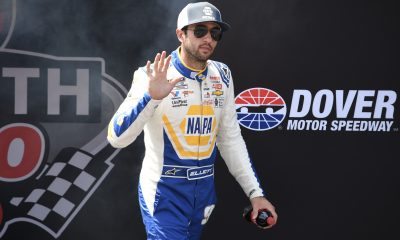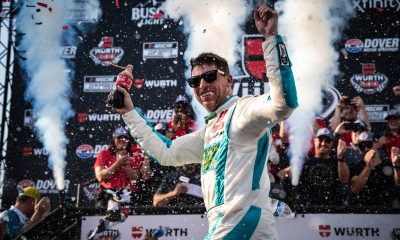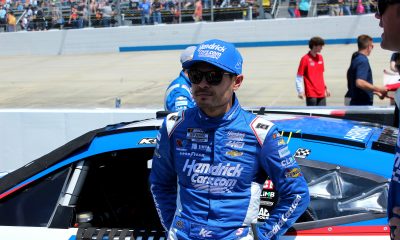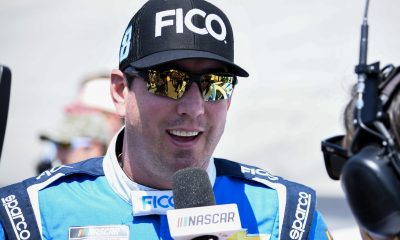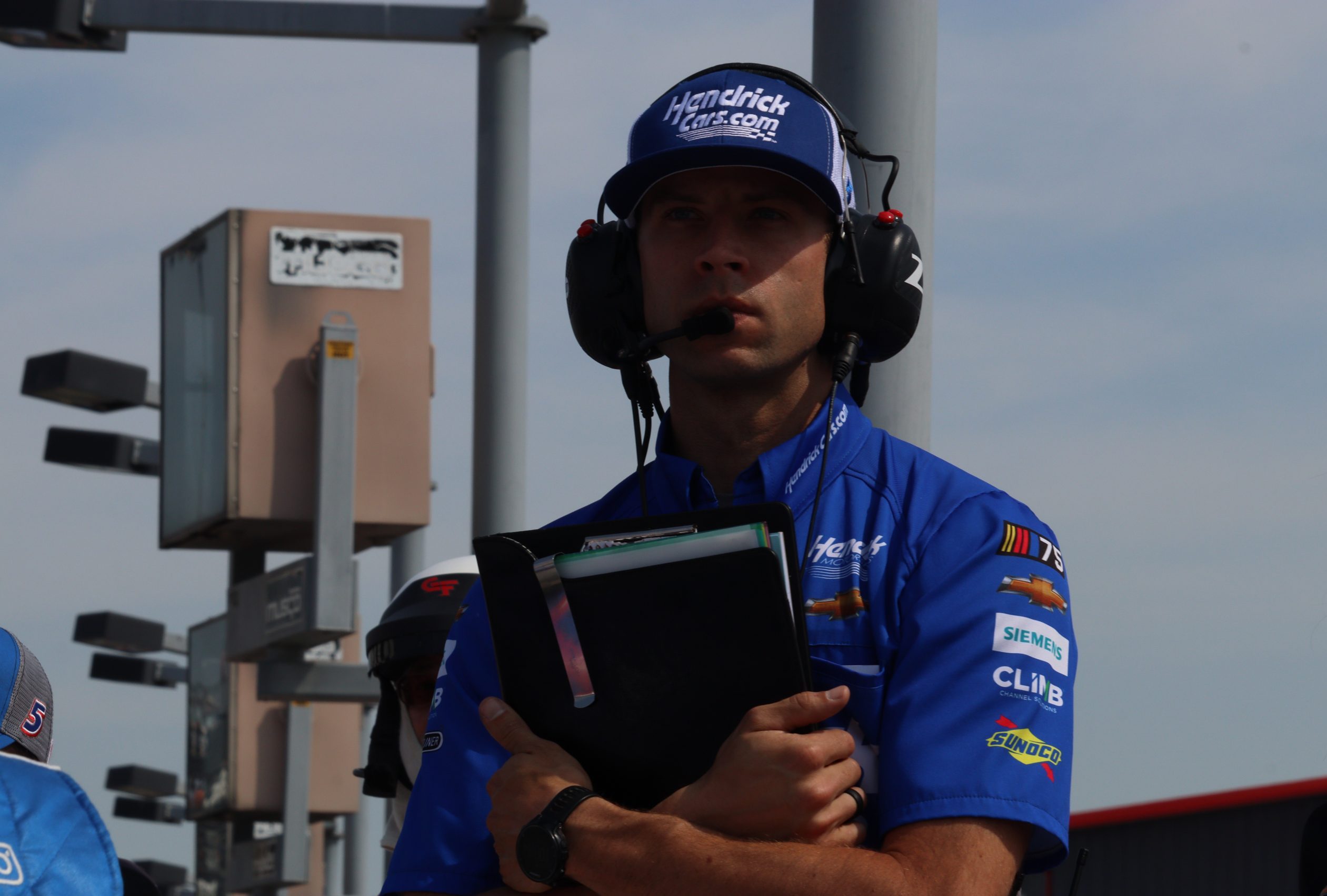
Cliff Daniels focuses intently on Kyle Larson’s practice laps around Gateway. (Photo: Bobby Krug | The Podium Finish)
By and far, Cliff Daniels’ path into racing may have taken an alternate path from his original intent. Still, the Smithfield, Virginia native has accomplished so much at the young age of 34 as one of the top crew chiefs in the NASCAR Cup Series.
Before Daniels honed his craft as an innovative, motivating leader atop the pit box, his dreams originally presided in the driver’s seat. During his childhood in Virginia, Daniels’ passion for racing sparked from working and spending time with his father at Langley Speedway and Martinsville Speedway.
Rather than wandering about and daydreaming at the track, Daniels focused intently and watched his father working on his late model car. Those formative years ignited a lifelong passion that is fervent in Daniels’ DNA and work ethic to this day with the No. 5 HendrickCars.com Chevrolet Camaro ZL1 team.
Trading his helmet and gloves for a cap and polo synonymous with crew chiefs, Daniels paid his dues, learning the technical nuances, team dynamics and importance of paying attention to every detail with his team, driver and car. From the short tracks of Virginia to the national spotlight of the NASCAR XFINITY Series and Cup Series, the University of North Carolina at Charlotte graduate made each of his experiences count as he climbed up the racing ladder.
As Daniels points out, his role as the crew chief of Kyle Larson and the No. 5 team is like being the head coach of a football or hockey team. In many ways, Daniels’ mind must run as fast as Larson’s No. 5 car in any race weekend session.
Of course, being a crew chief is more than just deciding on pit stop strategies or getting feedback from a driver on the track. In fact, it is like being the IT specialist, HR manager, team leader and glue that keeps everyone together through the ups and downs.
Of course, nobody is an island in any walk of life, especially in the case of Daniels and his Hendrick teammates. Every individual has something valuable to contribute to ensure the success of the team is sustained on a weekly basis as Daniels attests with his experiences.
Prior to the Enjoy Illinois 300 race weekend at World Wide Technology Raceway at Gateway, Daniels recalled his origins in racing as an observer and late model racer in Virginia. For any aspiring racer or crew chief pursuing their dreams in NASCAR or any motorsports series, Daniels’ story is inspirational and relatable.
For the first time here on The Podium Finish, we are going Atop the Pit Box with Cliff Daniels to learn more about his journey and the valuable experiences that paved the way to his role with the No. 5 team.
Tiongson : Cliff, you come from a racing family with your dad, Charlie, racing in late models from the 1980s to the 1990s. How did those experiences spark your interest in racing and what was your first immediate impression for you with that?
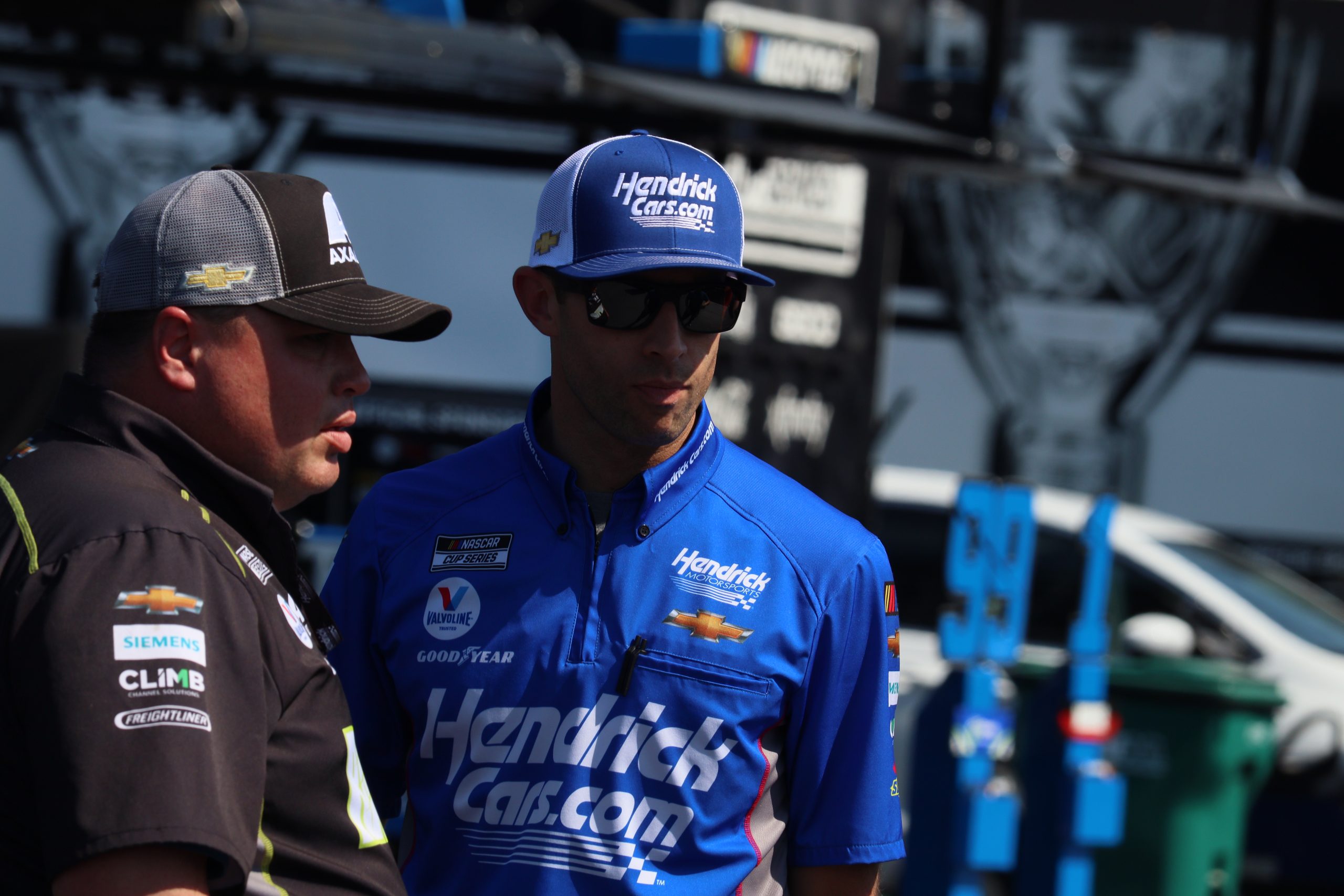
Daniels and Rudy Fugle confer over their teams during the Enjoy Illinois 300 race weekend at Gateway. (Photo: Bobby Krug | The Podium Finish)
Daniels : Yeah. That was really impactful on my childhood and just my interest as a young boy and wanting to be around race cars. I can remember at a very early age, I can’t quite remember how young, being with my dad and his late model team at Langley Speedway (and) Martinsville Speedway every year for the big 300 lap Martinsville late model stock car race, just all the things around him racing at the time were so impactful to me.
I had a big passion for what he did and just enjoyed following him around the shop and watching him work on the car. I would roll the tires around and all that sort of thing. So yeah, that was a big deal. And then he stopped racing really to focus on being there for my sister (Tiff) and I (with) baseball and softball and soccer and all the things.
And then I guess that was probably somewhere (when I was) 6 or 7 years old. Racing was still there for me as an interest. We watched the Cup races every Sunday, and I told my dad that I wanted to get into it. And so we got a go kart and then a Bandolero car and then kind of worked our way up from there.
Tiongson : That had to be a pretty neat moment for you and knowing your dad was a racer. I’m sure the decision for your dad to purchase those cars was easier. But if you were the first person in your family to dive into racing, I wouldn’t imagine that decision was going to be that easy, would you say?
Daniels : Yeah, for sure. And the interest within my family of being into racing and being race fans dates back before even my dad. His dad was very much into racing. And my dad has always told me stories when he was a kid where he and his brother and their dad would go to Charlotte, they would go to Martinsville, they would go to Richmond at the fairgrounds.
And we’re talking when these guys were kids. So in the 60s, certainly in the 70s, they would go. So for a long time, my family has always just had a passion for for NASCAR and local racing and have always been into it. So that’s two generations before me and and certainly carried on through me.
Tiongson : Certainly. And I know for a fact that it’s obviously showing in your current role as a crew chief, which we’ll get into here momentarily. But I wanted to dive into your formative years as a race car driver, because I recall that you raced late models specifically in South Boston in the mid 2000s.
How important were those years racing in late models from a driver standpoint to understand the characteristics of a race car?
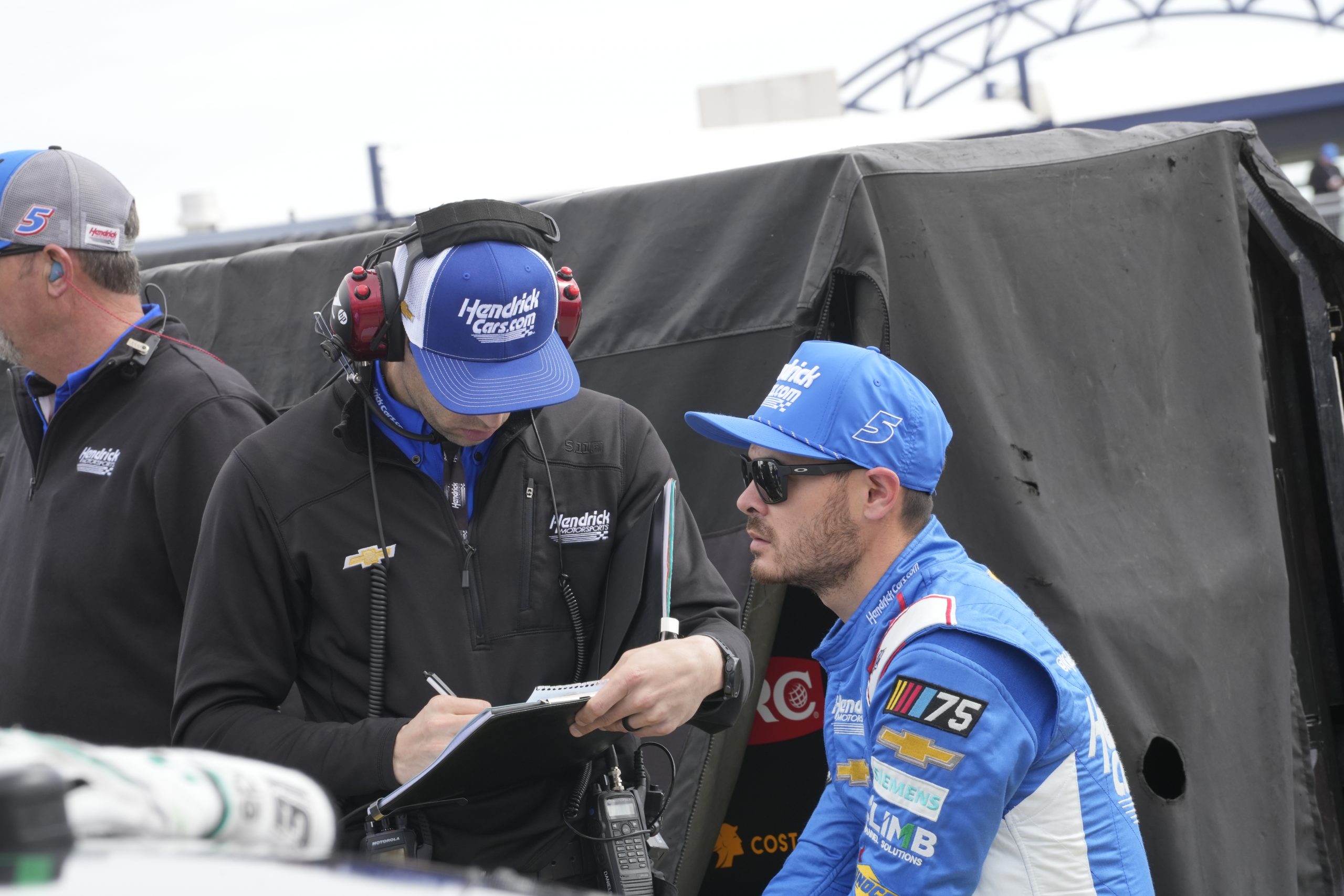
Daniels gained valuable experiences as a crew chief with his original path as a budding racer. (Photo: Christopher Vargas | The Podium Finish)
Daniels : It was twofold, the first part as a driver. There was just so many things that I learned and the sensations, just all the nuance to being in the seat and being in the competitive environment. Certainly, for many years of my life, I had aspirations to be a professional driver one day, racing from Legends cars all the way up to late models and spending the handful of years in late models at a lot of those tracks.
We always wanted to race against some of the toughest competition in the area, racing at South Boston Speedway, Southern National Speedway (and) a handful of other places. And then we did do some races on the at the time. It was the touring late model series that’s kind of morphed now into the CARS Tour Series.
Back then, we raced Bristol and Concord and other places like that. That had a really big impact on me on knowing how to adjust to and adapt to different tracks (and) understand the setup of your car in different ways. All of that was a big deal and had a big, big influence. Something else during that time that was a bigger influence on me than what I may have realized at the time was the amount of work that I was doing on my own car.
It was really me, my dad and one or 2 other guys that would do all the upkeep on our cars and and that would be anything from normal maintenance and, you know, cleaning the cars, repacking the wheel bearings, going through the rear end and all the things that you needed to do.
Plus, you know, setting up the car. And we always tried to kind of keep our eye out on any of the new setup tools that people had on how to use lasers or turn plates and all the things that we were trying to get ourselves accustomed to just for working on the cars.
For me, as someone who really wanted to make my career in racing, I was at the same time kind of building what I thought could turn into a professional driving career, but was also building my skill set and my depth of knowledge just for working on the cars and really being deeply hands on. I was doing all the work on on my car.
At the time my sister was in college, she really wasn’t able to to be home with us and work on her car. So I was doing all the upkeep on two cars and just balancing what that was, trying to make sure we had everything right, our cars were clean, looked good and well prepared and had them set up right for for what we thought we knew at the time.
That was some pretty formative years for me. And looking back on it now, I’m thankful to have had that time.
Tiongson : Things happen for a reason. And in a way, you were like Ray Evernham as he managed two teams in the 1990s. And here you are, as a young man, managing your family’s two late model cars. Like you said, you’re building your future in 2006.
You made a decision around 2006, 2007 and said, “You know what? I need to go to school. I’m going to go do a different direction into racing.” So when you graduated from UNC Charlotte, you worked your way to Kenny Wallace’s team, then to Tony Stewart’s team.
How much did those experiences build your confidence and knowledge in your role as an engineer and eventually as a crew chief?
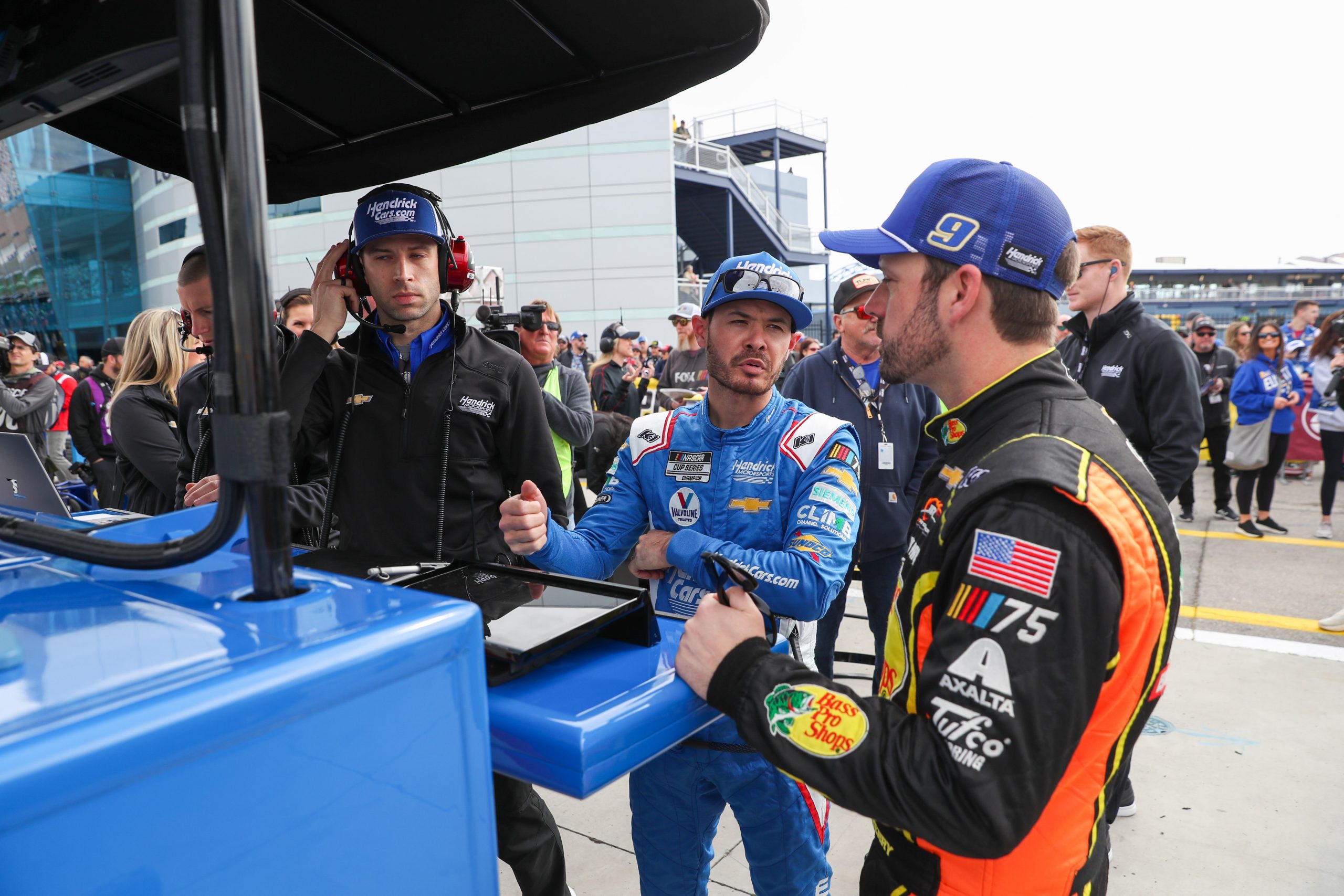
By all means, Daniels keeps in tune with Kyle Larson and his No. 5 team at all times. (Photo: Myk Crawford | The Podium Finish)
Daniels : Yeah, every one of those steps was so important to the journey and the path of what it took to get me here. I started college in 2006. And to your point, yeah, we did slow down some of our racing during that time. I want to say the last full time season I had was either ’07 or ’08. I graduated college in 2010.
A good friend of mine, Eddie Hunt, at the time, had a (NASCAR) Nationwide (Series) team, now Xfinity, and he also had an ARCA program. I got connected with him through college. I was volunteering for a little while. And then I was paid a little bit to help work on his team. I was just kind of an all around mechanic and I would kind of get beat up by some of the guys because I was green and I needed to learn those those types of cars and just how things would operate at the ARCA level and at the Nationwide level.
It was really good experience for me, to kind of be the low man on the totem pole and get knocked around a bit and have to learn the ways. Through some other connections, I got to RAB Racing (where) Scott Zipadelli was the crew chief. Kenny Wallace was our driver for a couple years. That was a great experience for me and one of the guys that had a big impact on my career. Travis Young, who is now the car chief on the No. 47 Cup car, was the car chief of our car at RAB. I was the engineer.
He and I had a great relationship and he was pretty tough on me at the time. Just to continue to build my depth of knowledge of how to handle that environment, how to race, we didn’t have a lot of resources. We didn’t have a lot of guys on the team. It was more than just behind the desk, computer based engineering work.
As the engineer on the team, he and I really did all of the mechanical work on the setup plate. Trace that back to a handful of years to where I was doing all this setup work on my late model. That experience really started to pay off in that environment. So that was big.
And then through the connection of Scott and Greg Zipadelli, I got a chance to go to Stewart-Haas Racing and be on the No. 14 car for a couple years. And honestly, still at that point in my career, I was young and probably a bit too tenacious at times and maybe rub people the wrong way as I was trying to learn.
But at the time, there was a lot of really good people at Stewart-Haas to help continue to build my skill set (and) give me some perspective on how to handle the Cup world and find the balance of always wanting to do things to to be better and make a car go fast versus what resources you do have at a Cup team that you can kind of rely on.
That had a big impact on on my career and kind of my perspective of getting into Cup racing. And then because Stewart-Haas and Hendrick Motorsports had a connection at the time, when there was a opening on the No. 48 team with Chad Canals and Jimmie (Johnson), their lead race engineer was taking a different role.
I got a chance to come over to Hendrick Motorsports and work on the No. 48 for a handful of years. So all of those steps of the journey and all those interactions with the people, the relationships that I built, the times where folks who had a lot of experience and were way smarter than me, knocked me around a bit and kind of taught me things that I needed to be aware of and things to see and pay attention to along the way. I’m very, very thankful for those moments and all certainly shaped so much of me and where I am today.
Tiongson : It sounds like you’ve had a really great journey and it’s no different than being a race car driver climbing up the racing ladder except for your side of things. You know, you had an initial path and then it still got you in the NASCAR Cup series competition just in a different way than you imagined as a kid.
I know a lot of folks like me and racing fans who follow the series know what a crew chief does. But let’s just imagine we’re talking to newer audiences who are getting into NASCAR, learning about you and the No. 5 team. What exactly do you do as a crew chief and what are some of your responsibilities during the race week and race weekend?
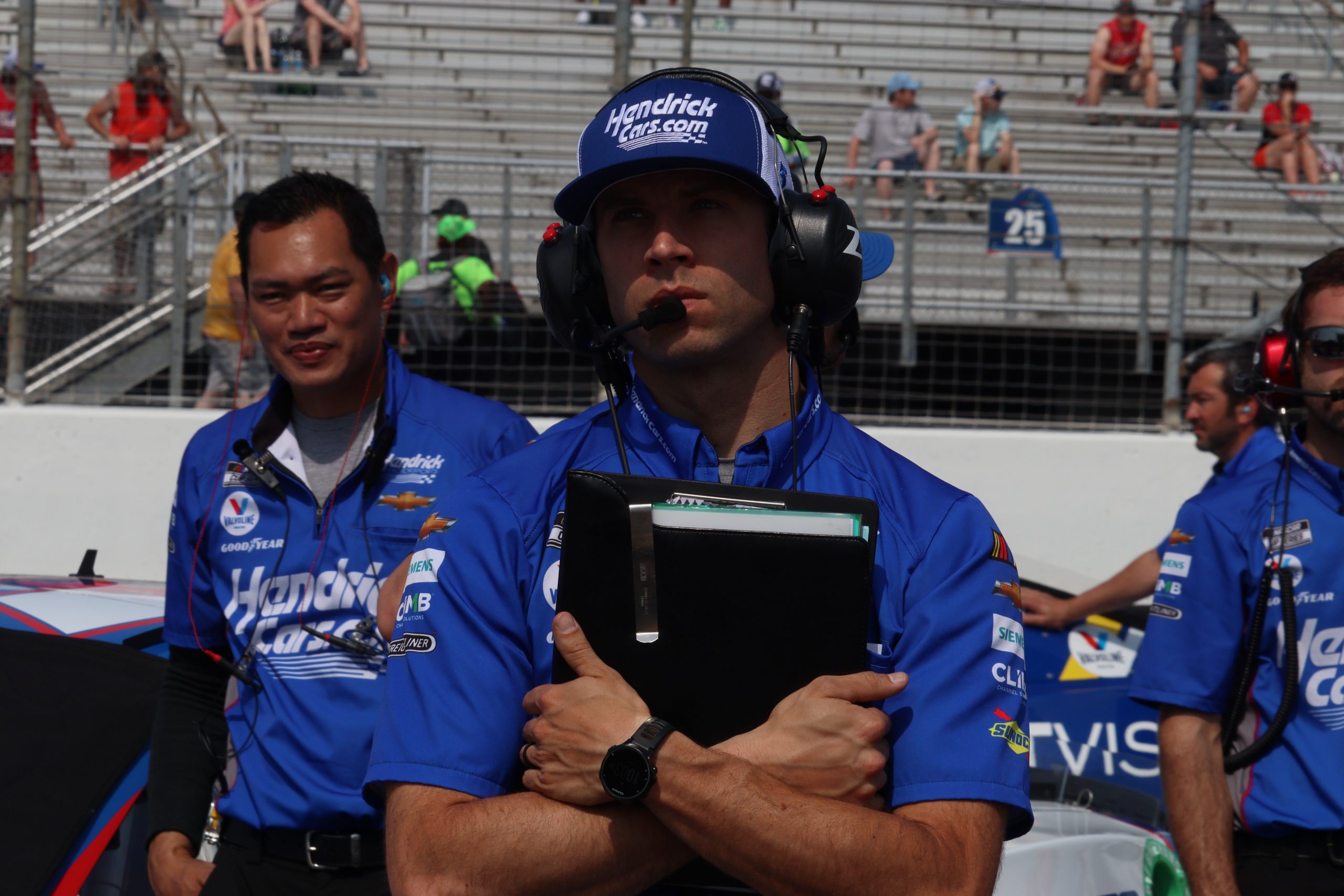
Daniels and Cesar Villanueva keep their sights set on consistent, strong weekends for Larson and the No. 5 team. (Photo: Bobby Krug | The Podium Finish)
Daniels : So one of the most common analogies that I could give to anyone who may be familiar with sports, but maybe not so much with NASCAR, the crew chief of the team is like the head coach of a team. And then we have a lead race engineer and we have a car chief. The lead race engineer would be like the offensive coordinator. The car chief would be like the defensive coordinator and the head coach or the crew chief.
In my role, we work very, very closely with the engineer on all the go fast things, all the car setup things, details about aerodynamics, the mechanical settings of the car tire settings of the car, work with the car chief, kind of on defense, of how to make sure the car is well prepared. Everything is mechanically sound, nothing is is going to fail, everything is just buttoned up and proper for how you want your race car to be presented to the racetrack to go race for 600 miles.
That’s really the largest scope of the job as a crew chief. But also within that at Hendrick Motorsports, we’ve got a lot of great people in our company and a lot of great people on our team. So it’s more than just working with the lead engineer and the car chief.
We have a shop based engineering group plus the shop based mechanical group, plus a lot of different groups and departments at Hendrick Motorsports that crew chiefs are very involved with and help make decisions on the direction that we’re going to go to find speed.
And that can be a lot of different departments from engineering, in any of the principles that you need to go fast from things being lighter or lower or farther to the left or working with the engine department on our next change from an engine package standpoint, different tracks, fuel mileage tracks versus horsepower tracks, how do we handle that balance, to even our competition systems department where the tools and the resources that we use at the track to execute a race, to call a race, how to develop those tools, a lot more of the scope that I would say is more shop based.
So, that’s kind of a general idea of what a crew chief does. And then on the weekends, I get to call practice, qualifying and the race. I’m the guy on the radio with the driver (and) the spotter, helping coordinate the strategy, helping make the driver aware (of) things that we see during the race to try to help make us better from an execution standpoint or from a car performance standpoint.
That’s really my job to… to work with the driver on that. And yeah, it’s a blessing to be in this position. It’s a lot of fun to do what I do and to be here at Hendrick Motorsports, (I’m) super thankful for that. It’s an amazing blessing to be here with such a great organization and such great people. It’s definitely a lot of fun and I’m very thankful to to have it.
Tiongson : Absolutely. And I really love hearing your story, Cliff. I hope we can catch up for a second part of this because we have a lot more to get to. I appreciate you joining me. Anything else you wanted to say to the race fans?
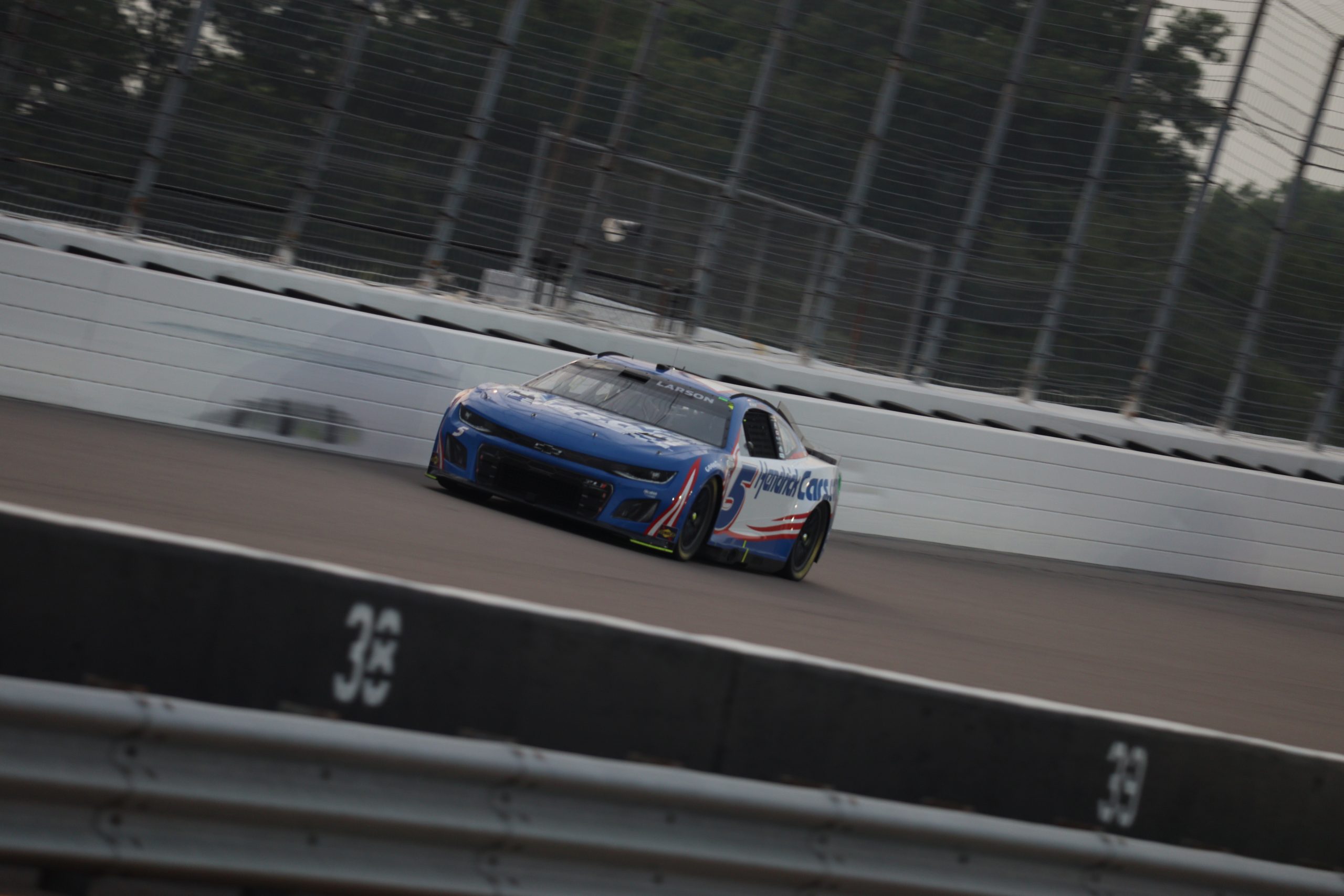
Above all else, Daniels enjoys his latest opportunity with Larson and the successes they have tallied since 2021. (Photo: Bobby Krug | The Podium Finish)
Daniels : Yeah, just as always, the lifeblood of our sport we maybe don’t acknowledge enough, but it is the race fans. The race fans are the ones that that watch us on TV and come to the racetrack and support us.
We know it. We feel it every week when when the crowd is cheering at the start of the race and all through the race. Thanks to all the fans and make sure you’re supporting the No. 5 HendrickCars.com Chevrolet.
Editor’s Notes
Special thanks to Cliff for taking his time to talk about his journey and experiences in the racing industry. Also, special thanks to Autumn Darracq on making this interview possible with Cliff!
Follow the progress of the No. 5 team throughout the 2023 NASCAR Cup Series season here on The Podium Finish. Also, stay tuned for the follow up interview with Cesar Villanueva, interior mechanic and tire specialist for the No. 5 team!
Rob Tiongson is a 30-something motorsports journalist who enjoys sports like baseball, basketball, football, soccer, track and field and hockey. A Boston native turned Austinite, racing was the first sport that caught his eyes. From interviews to retrospective articles, if it's about anything with an engine and four wheels, it'll be here on TPF, by him or by one of his talented columnists who have a passion for racing. Currently seeking a sports writing, public relations, or sports marketing career, particularly in motorsports. He enjoys editing and writing articles and features, as well as photography. Moreover, he enjoys time with his family and friends, traveling, cooking, working out and being a fun uncle or "funcle" to his nephew, niece and cat. Tiongson, a graduate of Southern New Hampshire University with a Bachelor of Arts in Communication, pursues his Master of Arts in Digital Journalism at St. Bonaventure University. Indeed, while Tiongson is proud to be from Massachusetts, he's an everywhere kind of man residing in Texas.

